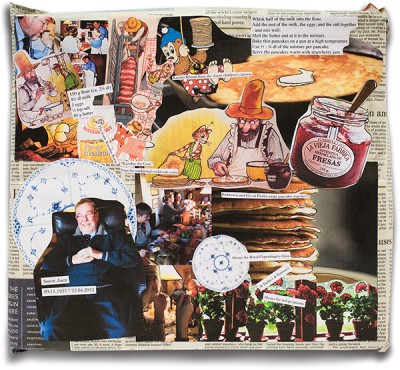
Photo: Tom Kates
For this piece, Karoline Aaen ’17 says she examined how “raw experiences” are “cooked” into memories, using her grandfather as the subject.
In the recent Hollister exhibit “Technologies of Memory,” students displayed work created for the new course “Memory and Forgetting,” which was developed by Sandra Graham for the revised first-year foundation curriculum in arts, history, and society. The course focuses on the cultural aspect of memory, says Graham, assistant professor of ethnomusicology, and helps students understand the ways in which memory—and forgetting—affect sociopolitical orders. It poses such questions as whose voices are heard and remembered, says Graham, and whose voices are forgotten, censored, or erased, and why? Two sections were offered, one for honor students.
Graham describes technologies of memory as “any means by which memory is transmitted,” from stories, recipes, and photographs to gravestones, museums, and landmarks. For a major part of their grade, students crafted projects that explored a particular theoretical concept of memory. The honors section then curated the Hollister exhibit with guidance from Danielle Krcmar, artist in residence. “Students responded with excitement, deep interest, and impressive creativity,” says Graham. “Some did oral histories of family members and uncovered treasure troves of artifacts and new knowledge about people they thought they knew. Others explored disasters and the ways in which these were remembered socially. Still others explored public memorials and monuments. There was a variety of interests and creative visions.”
In addition to the academic concepts that students acquired throughout the course, Graham hopes students enjoyed communicating with a broader public and celebrating a job well done via the exhibit. She wants them to take away an understanding that lessons from the classroom can inform everyday life in meaningful ways. “The challenging texts that we studied gradually became comfortable companions as the students found a way to apply them to topics that were personally significant,” she says. “Events, histories, and people they thought they knew took on new and deeper dimensions.”—Donna Coco
